Table of Contents
There are countless strategies for winning a game in Magic: the Gathering. Some are incredibly obscure, and others are more commonly used. That’s only to be expected for a card game that’s existed for almost thirty years and has tons of options to choose from.
Above all the possibilities out there, you’ll usually find three main strategies: aggro, midrange, and control. If you’d like to learn more about control, you can take a look at our post on tips for playing control.
However, the strategy we’re going to talk about today is aggro. We’ll start by explaining to you what it is.
Then we’ll give you some useful tips for playing aggro in MTG. Let’s get started.
What Does it Mean to Play Aggro in MTG?
If we asked you to guess what aggro means, you’d probably be able to form a theory even if you didn’t know much about Magic: the Gathering. Aggro is a shortened version of the word “aggressive,” and refers to using fast, offensive cards to batter your opponent.
When you’re playing an aggro deck, your goal is to reduce your opponent’s life points from 20 to 0 as fast as possible. You’ll want to flood your opponent with damage cards and hard-hitting creatures, rather than building a long-term plan.
Aggro decks are fast, trading card advantage for harsh damage. They’re created to strike before your opponent can build up their own battlefield. That means you’re using creatures that are typically easy to get out, making for incredibly quick games.
In other words, aggro means you’re smashing face…and you’re doing it lightning-fast. It’s a simple strategy to understand and play, so it’s a really good choice for beginners.
Tips for Playing Aggro in MTG
Mana curve like a boss.
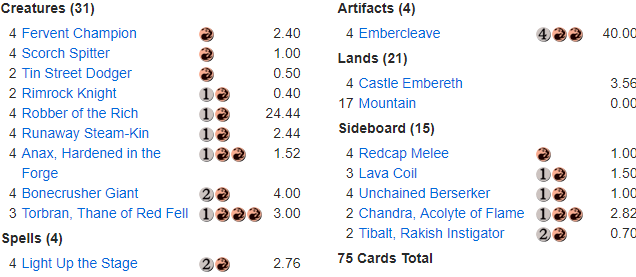
Your mana curve is important in all decks, but it’s especially vital in an aggro one. The majority of your cards should cost under three mana, because you’ll be able to swarm the board and overwhelm your opponents much more quickly.
Remember, your objective is to hit hard and fast. While high-costing cards generally are more powerful, it takes longer to build up the mana necessary to cast them. If you’re playing an aggro deck, you want to be able to play your cards as soon as possible to start smacking your opponent.
Above is a picture of a very generic mono-red aggro deck. As you can see, the deck has fourteen cards that only cost one mana. Building your deck like this all but guarantees you will have creatures out on turns one and two, so you can start hitting right away. A lower mana curve also allows you to play more cards per turn in the later stages of the game.
In our generic aggro deck, there are also fourteen two-mana cards. This is consistent with our low-cost one-two punch aggro strategy.
Then, we slow down a bit with our eight three-mana cards and our seven “finisher” cards that cost four mana or more. Those cards are intended to be the powerhouses of the deck to quickly close out games.
Embercleave may look needlessly expensive in this deck, considering you should ideally have a low mana curve. But there’s a great reason we’re choosing to use it, and we’ll explain more in our section on finisher cards.
Lands can help you.
For some decks, building a good mana base is incredibly complicated. The more colors you splash in a deck, the harder it is to ensure your mana base provides you ample access to all of them.
This is where aggro decks really shine. Because they tend to be one or two-color decks, choosing the right lands is a stress-free experience.
We usually recommend having between 17 and 21 lands in most builds. You want to get your land drops for the first three turns to ensure you have at least three out. Remember, you’re playing a deck with a low mana curve, so most of your cards will cost three or less mana.
That means that, after the first three turns, drawing land more than one turn in a row is basically useless. You want action cards after getting your first few lands. Because of this, you should add lands that benefit you by helping you get cards you need to win faster so they’re not as useless when you draw them later on.
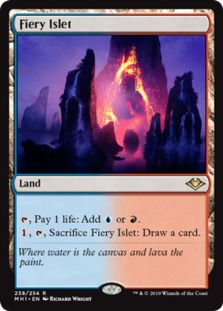
Fiery Islet is a great pick, as is Sunbaked Canyon. Both lands can be useful for red decks to play on curve, but can also be sacrificed later on so you can draw another card. That can be invaluable for helping you find that last piece of damage you need to dispatch your opponent.
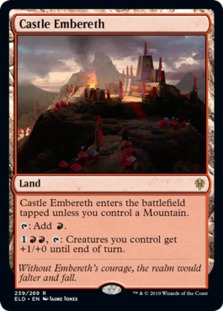
Castle Embereth is another amazing choice in Standard. It comes into play untapped if you already have a mountain out, which is almost always the case in a mono-red aggro deck.
It also has a built-in pump effect that hits all creatures on your board. Honestly, +1/+0 doesn’t seem like much, but trust us when we say it’s closed out many games for us. Furthermore, it doesn’t really cost you a spot in your deck since it operates just like a basic mountain by giving you mana.
Burn, baby, burn!
When we say “burn” in reference to aggro, we are referring to spells that damage your opponents or their creatures. It’s also called burn because many of these cards are red.
They’re useful in aggro decks because you can eliminate any blockers your opponent has. You can even use them to damage your opponent directly or as a finisher to hit the last few points of damage to their life total.
A good mix of burn and creatures is the key to building a truly powerful aggro deck.
One-drops are your friends.
One-drop cards are cards that only cost you one mana. Over time, they’ve gotten more and more powerful in Magic: the Gathering. Because of that, you have some awesome choices to include in your own aggro deck.
We’ll show you some of our favorite options and explain to you what makes them worthwhile. As we show you these cards, keep in mind that your main objective is to get as much fast damage as you can before your opponents assemble a response.
Some aggro decks will even play over sixteen one-drops to maximize their tempo.
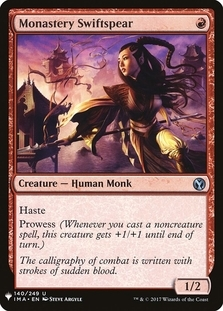
Monastery Swiftspear is a powerhouse for aggro. Having haste is nice to get some early damage in, and it works well alongside burn spells with the prowess ability. Every time you cast a burn spell, Monastery Swiftspear’s power and toughness will be temporarily boosted.
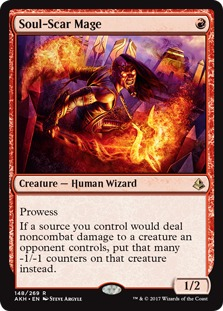
Soul-Scar Mage is similar to Monastery Swiftspear, carrying that 1/2 power and toughness with prowess for only a single mana. However, it has some hidden power in its ability which turns your burn damage into -1/-1 counters.
These counters can stay on the creature you target, instead of damage that “heals” at the end of the turn. This can be useful in removal of a creature in combat while protecting your own, because it effectively shrinks your opponent’s creature.
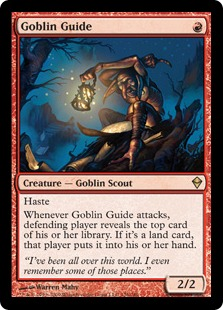
Goblin Guide is one of our favorite creatures of all time and it is one of the most aggressive one-drops you can play. It’s powerful because it’s a 2/2 for only a single mana, and haste allows you to swing with it immediately.
Wizards of the Coast tried to balance it more by adding the possibility of drawing your opponent a card when you swing, but with this strategy, that’s a small price to pay. We’ve had games where we’ve gotten 8-10 damage in from a single Goblin Guide.
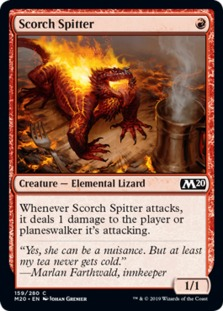
Scorch Spitter is a popular choice at the time of this article (summer 2020), and is annoying to deal with. Similar to Goblin Guide, it does two damage to your opponent each attack.
There’s a bonus here, though: its damage can’t be blocked because it triggers on attack. This can be helpful if you are playing cards with spectacle, such as Shatter that Stage. (Spectacle is a keyword that means a card is less expensive to cast if an opponent has taken damage this turn.)
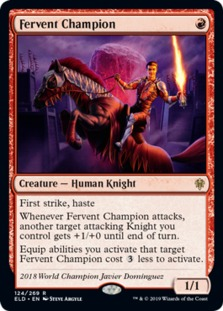
This is the last one-drop we’ll discuss: Fervent Champion. His art is based on last year’s world champion, and he is even holding the trophy as his sword – but don’t let this lore distract you.
Fervent Champion is an absolute beast. If you get multiples of him on the board, they can boost each other. We remember a few games where we played him on turn one, then two more on turn two, which is six damage on the second turn!
He also works well with Embercleave equipped to him. He is played in most mono-red aggro decks in Standard these days.
Finally, his first strike can be powerful if your opponent has a 3/3 creature and you have a Shock. You can’t quite remove the 3/3 with Shock, but if you attack and respond once they block, it reduces it to a 3/1. Your Fervent Champion can then easily finish it off through first strike without taking any damage.
Use Finishers.
The final step to any good aggro deck is closing out the game. We’ll call the cards you do this with “finishers.”
These cards are usually highly impactful when they hit the board. Current Standard has two cards we absolutely love because of how well they fill this role. Their interactions together are even better.
Let’s take a look at them, shall we?
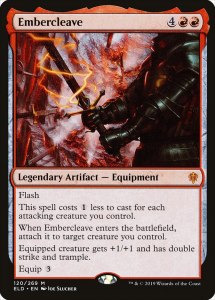
We’ve been in love with Embercleave since it was first spoiled. Equipment is something we’ve always loved, and this one is even spicier with the ability to flash in and function as a combat trick. (Combat trick refers to a card you use during combat to turn the tides or even finish the game.)
The key to using Embercleave is to wait until your opponents’ blockers are declared, so you know where to put it. Once that’s done, cast it in response to have it in play before the damage step.
This card looks expensive at a glance with its mana cost of six, but it’s reduced by one for each attacking creature. With that reduction, you’ll usually only be paying two or three mana for this highly impactful finisher.
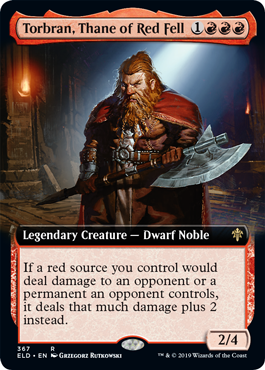
Okay, who wouldn’t love a dwarf named Torbran? All jokes aside, this is one card your opponents definitely won’t love.
At four mana, he’ll be at the higher end of your mana curve, but when he hits the board, he is so worth that cost. His ability adds two damage to any red source that would deal damage, so your creatures and burn spells all gain power.
This makes every card in your deck impactful. If you are playing a wide deck with a lot of small creatures when you drop him, he can usually close out the game.
Wrap Up
Hopefully, this post got you excited to whip up an aggro deck of your own. If you’re new to the game and are not sure what kind of deck to make, aggro is a wise choice because it’s simple and effective.
The cards we mentioned are critical to aggro decks you see in play right now, and will take your power to the next level. You’ll be able to hit your opponents before they even know what’s coming.
